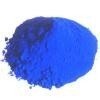PANJA DURRIE WEAVING
The weavers of the village of Salawas belong to the Prajapati caste. Although their main source of income was agriculture, they also practiced pottery and the weaving of jatpatti rugs. These plain wefts faced durries woven with coarse goat or camel hair derives their name from jhat, literally meaning haste, with which they could be executed.
The jatpatti were initially used as coverings for domestic animals during winters, as saddle bags, as filters for oil mills and for making tents. The traditionally used animal hair was replaced with cotton fiber in 1977 and these durries began to be sold to a small segment of the domestic market. The craftsmen began experimenting with stripes, geometrical and stylized natural forms such as the kangasi (comb), teer (arrow head), tota (parrot), chidia (sparrow) and chaukadi (rhombus).
Variously colored yarns are laboriously individually inserted to create these forms, thus also ensuring that the durries is reversible. As these durries acquired recognition they came to be known as panja durries due to the use of the panja,a comb -like beating tool.
Jawaja Dari
Probably the lesser known offspring of Artisans' Alliance, Jawaja, the durries of Beawar, Rajasthan, are no less than the leather craft of this 35 year old association. Durrie, the Indian counterpart of the carpet, is a non-pile rug that has its own unique colours, patterns and materials in different regions across the country. Just a few kilometers from Beawar, is the village of Beawar-Khas, where weavers of the Jawaja association make the characteristic thick and bright durries on their looms at home.
Weaving has been a traditional profession of the people of this village; craftsmen used to weave clothing fabric for local use. As attractive and cheaper synthetic fabrics started replacing the local handloom ones, the weavers needed another source of income, with the skills they had. With the formation of the association, they learnt how to make durries, which would be more profitable and have a wider reach.
Jawaja durries are typically thicker than other rugs, with the use of strong and thicker yarns for weaving. Craftsmen source cotton, wool and jute yarns from the nearby town of Beawar and prepare the warp and bobbins at home. While bobbins are wound with a Charkha, the loom does not consume any electricity either. Once on the loom, an average sized durrie of about 4' x 6' may take two to three days for completion.
The characteristic striped and geometric patterns are part of the emergence and evolution of this craft. Flaming oranges and magenta translated on to durries, from their own odhanis and turbans, bright blues and greens, to counter the lack of it in the surroundings, and subtle harmonies of warm greys of undyed wool are all found in these durries.
Wool carpets to keep warm in the biting cold winter of the north, comfortable cotton for the humid south and jute for strength, each material is woven, sometimes mixed, can spoil everyone for choice.
Although the lure of city jobs takes youngsters away from traditional crafts, weavers who once provided for local needs, now send their beautiful hand-woven creations to decorate homes all over the world.
Select Your Next Chapter

Paithani
Paithani is a varient of Traditional Sari, named after the Paithan village in Aurangabad, Maharashtra state of India where these sari's where hand woven.

Kashmiri Shawls
Of the myriad varieties of textiles for which India was famous over much of Europe and Asia from at least the time of the Roman Empire, the Kashmir shawl stands out as the only woollen one.

Block printing
Records show that as far back as the 12th century, several centers in the south, on the western and eastern coasts of India became renowned for their excellent printed cotton.

Natural Vedetable Dyes
The art of making natural dyes is one of the oldest known to human. In India, it was used for colouring fabric and other materials.

Durries
>The weavers of the village of Salawas belong to the Prajapati caste. Although their main source of income was agriculture, they also practiced pottery and the weaving of jatpatti rugs.
Select Your Next Chapter

Sarees
'Jamdani' is a heritage handloom products of Bengal handloom. Word 'Jamdani' - derived from a "PERSION" word 'JAM' meaning a 'cup' and 'DANI' denotes the 'container'.

Pichwai
India, wrapped in mystique, enhanced with the romance of fabled crafts, has one of the finest textile traditions in the world. Rajasthan is the home rather museum of paintings.